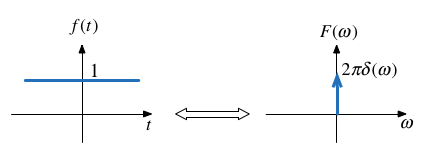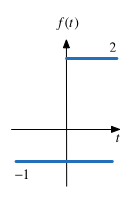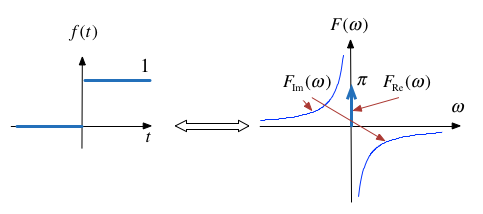The Fourier Transform (Part 2)¶
Agenda¶
Last Hour
- Fourier Transform as the Limit of a Fourier Series
- Doing the Maths
- Special forms of the Fourier Transform
- Properties of the Fourier Transform
- Computing Fourier Transforms in Matlab
This Hour
- Tables of Transform Pairs
- Examples of Selected Transforms
- Relationship between Laplace and Fourier
- Fourier Transforms of Common Signals
Scope and Background Reading¶
This session continues our introduction to the Fourier Transform with several examples extracted from tables of transform tables.
The material in this presentation and notes is based on Chapter 8 (Starting at Section 8.4) of Steven T. Karris, Signals and Systems: with Matlab Computation and Simulink Modelling, 5th Edition. from the Required Reading List. I also used Chapter 5 of Benoit Boulet, Fundamentals of Signals and Systems from the Recommended Reading List.
Reminder of the Definitions¶
Last time we derived the Fourier Transform by evaluating what would happen when a periodic signal was made periodic. Let us restate the definitions.
The Fourier Transform¶
In the signals and systems context, the Fourier Transform is used to convert a function of time $f(t)$ to a function of radian frequency $F(\omega)$:
$$\mathcal{F}\left\{f(t)\right\} = \int_{-\infty}^{\infty} f(e)e^{-j\omega t}\,dt = F(\omega).$$
The Inverse Fourier Transform¶
In the signals and systems context, the Inverse Fourier Transform is used to convert a function of frequency $F(\omega)$ to a function of time $f(t)$:
$$\mathcal{F}^{-1}\left\{F(\omega)\right\} = \frac{1}{2\pi}\int_{-\infty}^{\infty} F(\omega)e^{j\omega t}\,d\omega = f(t) .$$
Duality of the transform¶
Note the similarity of the Fourier and its Inverse.
This has important consequences in filter design and later when we consider sampled data systems.
Table of Common Fourier Transform Pairs¶
This table is adapted from Table 8.9 of Karris. See also: Wikibooks: Engineering Tables/Fourier Transform Table and Fourier Transfom—WolframMathworld for more complete references.
| **Name** | $f(t)$ | $F(\omega)$ | **Remarks** | |
| 1 | Dirac delta | $\delta(t)$ | 1 | Constant energy at *all* frequencies. |
| 2 | Time sample | $\delta(t-t_0)$ | $e^{j\omega t_0}$ | |
| 3. | Phase shift | $e^{j\omega t_0}$ | $2\pi\delta(\omega - \omega_0)$ | |
| 4. | *Signum* | $\operatorname{sgn} (x)$ | $$\frac{2}{j\omega}$$ | also known as sign function |
| 5. | Unit step | $u_0(t)$ | $$\frac{1}{j\omega}+\pi\delta(\omega)$$ | |
| 6. | Cosine | $\cos \omega_0 t$ | $\pi\left[\delta(\omega-\omega_0)+\delta(\omega+\omega_0)\right]$ | |
| 7. | Sine | $\sin \omega_0 t$ | $-j\pi\left[\delta(\omega-\omega_0)-\delta(\omega+\omega_0)\right]$ | |
| 8. | Single pole | $e^{-at}u_0(t)$ | $$\frac{1}{j\omega + a}$$ | $a \gt 0$ |
| 9. | Double pole | $te^{-at}u_0(t)$ | $$\frac{1}{(j\omega + a)^2}$$ | $a \gt 0$ |
| 10. | Complex pole (cosine component) | $e^{-at}\cos \omega_0 t\;u_0(t)$ | $$\frac{j\omega + a}{((j\omega + a)^2+\omega^2}$$ | $a\gt 0$ |
| 11. | Complex pole (sine component) | $e^{-at}\sin \omega_0 t\;u_0(t)$ | $$\frac{\omega}{((j\omega + a)^2+\omega^2}$$ | $a\gt 0$ |
| 12. | Gating function (*aka* $\operatorname{rect} (T)$) | $A\left[u_0(t + T)-u_0(t - T)\right]$ | $$2AT\frac{\sin\omega T}{\omega T}$$ |
Some Selected Fourier Transforms¶
Relationship between f(t) and F(omega)¶
In most of the work we will do in this course, and in practice, the signals that we use with the Fourier transform will be a real continuous aperiodic functions of time that are zero when $t = 0$.
The Fourier transforms of such a signals will be complex continous function of frequency which have real and imaginary parts and will exist at both positive and negative values of $\omega$.
It is often most convenient to deal with the transformed "spectrum" by considering the magnitude and phase and we will therefore often plot $F(\omega)$ on two separate graphs as magnitude $|F(\omega)|$ and phase $\angle F(\omega)$ (where phase is measured in radians) plotted against frequency $\omega \in [-\infty,\infty]$ (in radians/second).
We most often represent the system by its so-called frequency response and we will be interested on what effect the system has on the signal $f(t)$.
As for the Laplace transform, this is more conveniently determined by exploiting the time convolution property. That is by performing a Fourier transform of the signal, multiplying it by the system's frequency response and then inverse Fourier transforming the result.
Have these ideas in mind as we go through the examples in the rest of this session.
The Dirac Delta¶
$$\delta(t) \Leftrightarrow 1$$

Proof: uses sampling and sifting properties of $\delta(t)$.
Matlab:
syms t;
fourier(dirac(t))
ans = 1
Related:
$$\delta(t-t_0) \Leftrightarrow e^{-j\omega t_0}$$
Matlab:
syms t omega;
A = sym(1);
fourier(A,omega)
ans = 2*pi*dirac(omega)
Related by frequency shifting property:
$$e^{j\omega_0 t} \Leftrightarrow 2\pi\delta(\omega-\omega_0)$$
Cosine (Sinewave with even symmetry)¶
$$\cos(t) = \frac{1}{2}\left(e^{j\omega_0 t}+e^{-j\omega_0 t}\right) \Leftrightarrow \pi\delta(\omega - \omega_0) + \pi\delta(\omega + \omega_0)$$
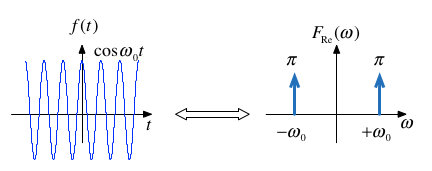
Note: $f(t)$ is real and even. $F(\omega)$ is also real and even.
Sinewave¶
$$\sin(t) = \frac{1}{j2}\left(e^{j\omega_0 t}-e^{-j\omega_0 t}\right) \Leftrightarrow -j\pi\delta(\omega - \omega_0) + j\pi\delta(\omega + \omega_0)$$
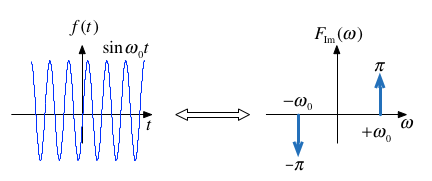
Note: $f(t)$ is real and odd. $F(\omega)$ is imaginary and odd.
Signum (Sign)¶
The signum function is a function whose value is equal to
$$\operatorname{sgn} x = \left\{ {\begin{array}{*{20}{c}} { - 1\;x < 1} \\ {0\;x = 0} \\ { + 1\;x > 0} \end{array}} \right.$$
The transform is:
$$\operatorname{sgn} x = u_0(t) - u_0(-t) = \frac{2}{j\omega}$$

This function is often used to model a voltage comparitor in circuits.
Example 4: Unit Step¶
Use the signum function to show that $$\mathcal{F}\left\{u_0(t))\right\} = \pi\delta(\omega)+\frac{1}{j\omega}$$
Example 5¶
Use the results derived so far to show that
$$e^{j\omega_0 t}u_0(t)\Leftrightarrow \pi\delta(\omega - \omega_0) + \frac{1}{j(\omega-\omega_0)}$$
Hint: linearity plus frequency shift property.
Example 6¶
Use the results derived so far to show that
$$\sin \omega_0 t\; u_0(t)\Leftrightarrow \frac{\pi}{j2}\left[\delta(\omega-\omega_0)-\delta(\omega+\omega_0)\right] + \frac{\omega_0}{\omega_0^2 - \omega^2}$$
Hint: Euler's formula plus solution to example 2.
Example 7¶
Use the result of Example 3 to determine the Fourier transform of $\cos\omega_0 t\; u_0(t)$.
Answer¶
$$\cos\omega_0 t\; u_0(t)\Leftrightarrow \frac{\pi}{2}\left[\delta(\omega-\omega_0)+\delta(\omega+\omega_0)\right] + \frac{j\omega}{\omega_0^2 - \omega^2}$$
Derivation of the Fourier Transform from the Laplace Transform¶
If a signal is a function of time $f(t)$ which is zero for $t\le 0$, we can obtain the Fourier transform from the Lpalace transform by substituting $s$ by $j\omega$.
Example 8: Single Pole Filter¶
Given that
$$\mathcal{L}\left\{e^{-at}u_0(t)\right\} = \frac{1}{s + a}$$
Compute
$$\mathcal{F}\left\{e^{-at}u_0(t)\right\}$$
Example 9: Complex Pole Pair cos term¶
Given that
$$\mathcal{L}\left\{e^{-at}\cos\omega_0 t\;u_0(t)\right\} = \frac{s+a}{(s + a)^2+\omega_0^2}$$
Compute
$$\mathcal{F}\left\{e^{-at}\cos\omega_0 t\;u_0(t)\right\}$$
Fourier Transforms of Common Signals¶
We shall conclude this session by computing as many of the the Fourier transform of some common signals as we have time for.
- rectangular pulse
- triangular pulse
- periodic time function
- unit impulse train (model of regular sampling)
Suggestions for Further Reading¶
Boulet has several interesting amplifications of the material presented by Karris. You would be well advised to read these. Particular highlights which we will not have time to cover:
- Time multiplication and its relation to amplitude modulation (pp 182—183).
- Fourier transform of the complex exponential signal $e^{(\alpha +j\beta)t}$ with graphs (pp 184—187).
- Use of inverse Fourier series to determine $f(t)$ from a given $F(j\omega)$ and the "ideal" low-pass filter (pp 188—191).
- The Duality of the Fourier transform (pp 191—192).
End of Second Hour¶
Summary
- Tables of Transform Pairs
- Examples of Selected Transforms
- Relationship between Laplace and Fourier
- Fourier Transforms of Common Signals
Next Time
- The Fourier Transform for Systems and Circuit Analysis
